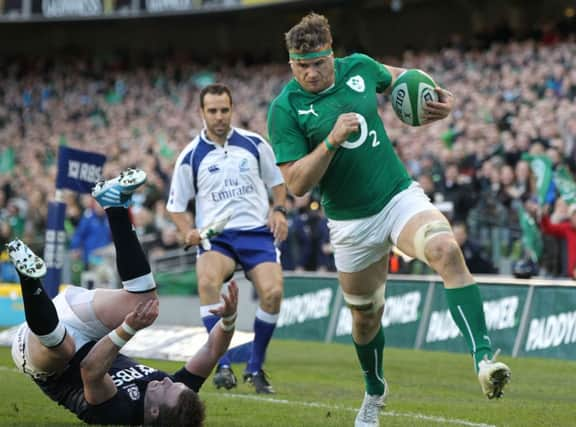David Ferguson: Scottish rugby’s inadequate system


He was critical of the Scottish pack’s performance against Ireland – rightly, as it was lamentable – but also was accurate in his assessment that the problems in Scottish rugby run far deeper. To cynics sensing another coach distancing himself, the Welshman quickly accepted blame for the performance.
We can argue over the merits of the players and coaches, but while we do that we’re ignoring the elephant in the room: Scottish rugby and its woefully inadequate system of development. What other professional sport would accept a ‘system’ where the most talented players disappear into a vacuum at the age of 17/18 and rather than be exposed to ever-more demanding games they drop off whatever intensity they experienced as an early to mid-teen?
Advertisement
Hide AdAdvertisement
Hide AdThe SRU have twisted this way and that over the past 20 years to find a structure and while, as the governing body, they are the main culprit in failing to achieve anything significant and lasting, they occupy a packed dock.
I grew up in a Borders school that had 1st XV fixtures from September to March, a national schools cup competition that brought us a run of games and end-of-season sevens tournaments. We won many games, but were stuffed in others, notably by independent schools, but the fixture list ensured frequent challenges.
That school, in common with all in the Borders, no longer turns out regular 1st XV teams. They appear for a few games in the Scottish Schools Cup/Plate/Bowl, but development at that level is now left to local clubs who acted in the best interests of the young players and their clubs when schools began to ship extra-curricular rugby.
We can talk about the inconsistency that brings in voluntary coaching, from exceptional to poor, but in reality there are too many such knock-on problems to detail in one column. The key at the heart of it all, for me, is simple – the lack of games of rugby.
That is where players learn most. That is where tighthead props are tested, learn, are tested again – for ‘tested’ you can substitute ‘hurt’ – and it is similar with stand-offs, for whom there is no greater embarrassment than failing to execute kicks properly, get passes to hand or tackle than in front of a crowd including peers, parents and local reporters. Hurt and embarrassment, crucial natural spurs to learning in rugby, do not exist to the same degree on a training field, and so development can never be as quick there.
Yet, the reason we are talking about players ‘maturing at 24/25 years of age’, which Humphreys wants to stop, is because players like Duncan Weir, Ruaridh Jackson, Moray Low, Ross Ford, Ryan Grant, even Kelly Brown, the skipper, did only start to mature in international rugby at those ages. Because from 17-22 they did not play regular competitive rugby – the period where their peers in England, Ireland, Wales and France are being put through the mill.
There has been no academy system for these players to hone their skills, develop the necessary physique and play week in week out in Scotland, and too few opportunities to play in the two-team pro arena. Mark Bennett, who left Glasgow for Clermont Auvergne, must wonder why he came back. He may be ‘learning’ from Gregor Townsend, but he hardly plays any rugby.
Tommy Allan turned down Edinburgh because he could not see a route to regular rugby. The 20-year-old joined Perpignan instead and made his Six Nations debut for Italy against Wales on Saturday.
Advertisement
Hide AdAdvertisement
Hide AdWeir played 30 minutes of rugby in the six weeks prior to Sunday’s game with Ireland, as Townsend tried to give Jackson a run of starts to develop. Glasgow have 53 players to keep happy and games to win, and, while important in other ways, handing pros amateur club matches does not develop Test performers.
The oft-promised district academies are still to launch and the clubs are queuing up to knock down the SRU’s latest plan for a more professional top club tier.
As SRU director of rugby in the 1990s, Jim Telfer asked all of Scotland’s independent school headteachers to support a national schools league, pitching the best against each other at 16-18 years, but one voted against it and, in an intriguing show of ‘independent’ solidarity, the rest decided ‘one out, all out’.
The crusade has continued. Colin Thomson, the SRU’s director of rugby operations, treks to innumerable meetings across the country with schools, clubs and coaches, seeking a competitive Scotland-wide youth/academy structure, but when supported in one place, he is condemned in another.
The SRU, sportscotland Institute of Sport and clubs have improved the training of young players, Ayr now and Stirling County, still, flag-bearers for youth development in the west and midlands while the Borders hangs on to its semi-junior league. But then what? Where does Scotland’s talent go for the next, intense test, the springboard to pro and Test rugby, in the crucial 17-20 years?
Humphreys is right. Scottish rugby does not develop its players for a professional and international game. Instead, we throw players into it and hope for the best, and then demand answers when they fall short.